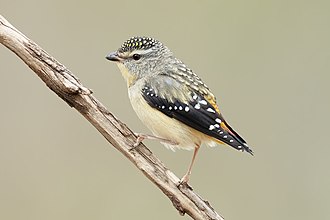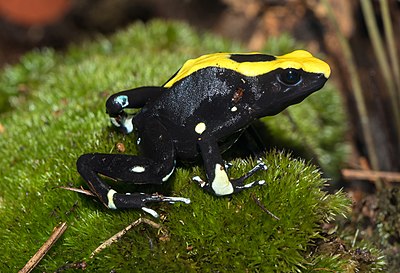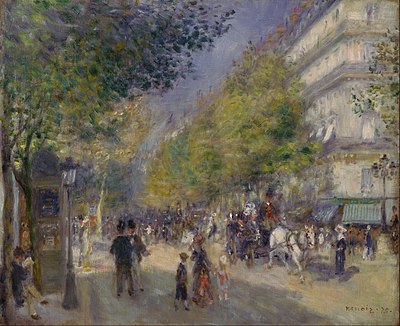Wikipedia:Picture of the day/Archive
|
Featured picture tools: |
These featured pictures, as scheduled below, appeared as the picture of the day (POTD) on the English Wikipedia's Main Page in the last 30 days.
You can add an automatically updating POTD template to your user page using {{Pic of the day}} (version with blurb) or {{POTD}} (version without blurb). For instructions on how to make custom POTD layouts, see Wikipedia:Picture of the day.Purge server cache
March 11

|
|
Cox and Box, also known as The Long-Lost Brothers, is a one-act comic opera with a libretto by F. C. Burnand and music by Arthur Sullivan, based on the 1847 farce Box and Cox by John Maddison Morton. It premiered in 1866 and was Sullivan's first successful comic opera. The story concerns a landlord who lets a room to two lodgers, one who works at night and one who works during the day. When one of them has the day off, they meet each other in the room and tempers flare. Sullivan wrote this piece five years before Thespis, his first opera with W. S. Gilbert. This poster was produced for the first professional production of Cox and Box, which began in 1869 at the Royal Gallery of Illustration in London and ran for 264 performances there. The opera has frequently been used as a curtain raiser for the shorter Gilbert and Sullivan operas and continues to be frequently produced. Poster credit: Alfred Concanen; restored by Adam Cuerden
Recently featured:
|
March 10

|
Picea abies, commonly known as the Norway spruce, is a species of spruce native to northern, central and eastern Europe. It has branchlets that typically hang downwards, and the largest cones of any spruce, at 9 to 17 centimetres (3.5 to 6.7 in) long. It is very closely related to the Siberian spruce, which replaces it east of the Ural Mountains, and with which it hybridizes freely. The Norway spruce has a wide distribution of planting for its wood, and is the species used as the main Christmas tree in several countries around the world. It was the first gymnosperm to have its genome sequenced. This young female Norway spruce cone, with a length of 43 millimetres (1.7 in) at the time of pollination, was photographed in Keila, Estonia. Photograph credit: Ivar Leidus
Recently featured:
|
March 9

|
The spotted pardalote (Pardalotus punctatus) is a small passerine bird native to eastern and southern Australia, at elevations of up to 2,000 metres (6,600 ft). It is part of the pardalote family, Pardalotidae. Weighing around 6 grams (0.21 oz), with a length of 8 to 10 cm (3.1 to 3.9 in), the adult male of the nominate subspecies has grey-brown upperparts with numerous paler buff spots, a black crown, wings and tail all with white spots, white eyebrows and reddish rump. The female is duller overall. This female spotted pardalote was photographed close to Glen Davis, New South Wales, Australia. Photograph credit: J. J. Harrison
Recently featured:
|
March 8
.jpg/350px-Rosalind_Goodrich_Bates_(1931).jpg)
|
Rosalind Goodrich Bates (1894–1961) was an American lawyer and clubwoman, based in Los Angeles, California. She was a founder and served as the president of the International Federation of Women Lawyers. This photograph of Bates, taken around 1931, is part of the Los Angeles Times Photographic Collection at the UCLA Library. Photograph credit: unknown; restored by Adam Cuerden
Recently featured:
|
March 7
Silver certificates are a type of representative money issued between 1878 and 1964 in the United States as part of its circulation of paper currency. They were produced in response to silver agitation by citizens who were angered by the Coinage Act of 1873, which had effectively placed the United States on a gold standard. Since 1968 they have been redeemable only in Federal Reserve Notes and are thus obsolete, but they remain legal tender at their face value and hence are still an accepted form of currency. These are six banknotes from the 1880 series of large-size silver certificates, designed by the Bureau of Engraving and Printing and comprising eight denominations from $1 to $1000. Each banknote bears a portrait of a different individual, identified above. Banknote design credit: Bureau of Engraving and Printing; photographed by Andrew Shiva
Recently featured:
|
March 6

|
Penyal d'Ifac Natural Park is a 45-hectare natural park situated in Calpe, in the Valencian Community of Spain. It was given natural-park status in 1987. The park is centred on the Penyal d'Ifac, a 332-metre (1,089 ft) limestone outcrop emerging from the sea that is linked to the shore by an isthmus of rock debris. The park is home to numerous rare plants, including a number of endemic species, and more than 300 species of animals, and a nesting site for colonies of sea birds and other birds. Photograph credit: Diego Delso
Recently featured:
|
March 5

|
The dyeing poison dart frog (Dendrobates tinctorius) is a species of poison dart frog. It is among the largest species, reaching lengths of 50 millimetres (2.0 in). It is distributed throughout the eastern portion of the Guiana Shield, including parts of French Guiana, Guyana, Suriname and Brazil. This dyeing poison dart frog was photographed in the Karlsruhe Zoo in Germany. Photograph credit: H. Zell
Recently featured:
|
March 4

|
Haane Manahi (1913–1986) was a New Zealand Māori soldier who served in the Second World War with the Māori Battalion. He joined the battalion in 1939 and fought in the German invasion of Greece, the Battle of Crete and the North African campaign. In April 1943, during the Tunisian campaign, his gallantry in an action at Takrouna resulted in a recommendation, supported by four generals, that he be awarded the Victoria Cross. This was downgraded to an award of the Distinguished Conduct Medal, which disappointed many of his fellow soldiers. After his death in a car crash in 1986, representations were made for a posthumous award of the Victoria Cross for his valour at Takrouna. These representations were unsuccessful but eventually resulted in a special award in 2007 of an altar cloth for use in a local church, a ceremonial sword, and a personal letter from Queen Elizabeth II in recognition of his gallantry. This June 1943 photograph of Manahi was taken in Maadi, Egypt, by George Robert Bull, the official photographer of the New Zealand armed forces. Photograph credit: George Robert Bull; restored by Adam Cuerden
Recently featured:
|
March 3

|
The Wine Glass is an oil-on-canvas painting by Johannes Vermeer, created around 1660. It portrays a seated woman and a standing man drinking in an interior setting. The work follows the Delft School convention of genre painting, developed by Pieter de Hooch in the late 1650s. It contains figures situated in a brightly lit and spacious interior, while its architectural space is highly defined. The figures are set in the middle ground, rather than positioned in the foreground. The Wine Glass is now in the collection of the Gemäldegalerie in Berlin, Germany. Painting credit: Johannes Vermeer
Recently featured:
|
March 2
_male%2C_Beaulieu%2C_Hampshire.jpg/300px-Stonechat_(Saxicola_rubicola)_male%2C_Beaulieu%2C_Hampshire.jpg)
|
The European stonechat (Saxicola rubicola) is a small passerine bird in the Old World flycatcher family, Muscicapidae. It is found across Europe, as far east as Ukraine and the South Caucasus, and in parts of North Africa. It breeds in heathland, coastal dunes and rough grassland, and is either short-distance migratory or non-migratory, with part of the population moving south to winter further south in Europe and more widely in northern Africa. European stonechats are 11.5 to 13 centimetres (4.5 to 5.1 in) long and weigh 13 to 17 grams (0.46 to 0.60 oz), with both sexes having short wings. The summer male has black upperparts, a black head, an orange throat and breast, and a white belly and vent, while the female has brown upperparts and head, and no white neck patches, rump or belly. This male European stonechat was photographed in Beaulieu in Hampshire, England. Photograph credit: Charles J. Sharp
Recently featured:
|
March 1

|
|
Castle Bravo was the first in a series of high-yield thermonuclear-weapon design tests conducted by the United States at Bikini Atoll in the Marshall Islands, as part of Operation Castle. Detonated on March 1, 1954, the device was the most powerful nuclear device detonated by the United States and the first lithium deuteride–fueled thermonuclear weapon tested using the Teller–Ulam design. Castle Bravo's yield was 15 megatonnes of TNT (63 petajoules), 2.5 times the predicted 6 megatonnes of TNT (25 petajoules), due to unforeseen additional reactions involving lithium-7, which led to radioactive contamination in the surrounding area. This photograph shows the Castle Bravo nuclear device, known as SHRIMP, in its shot cab. Photograph credit: United States Atomic Energy Commission; restored by Bammesk
Recently featured:
|
February 29

|
|
Les Huguenots is an opera in five acts by Giacomo Meyerbeer. One of the most popular and spectacular examples of grand opera, it sets a French-language libretto by Eugène Scribe and Émile Deschamps and premiered in Paris on 29 February 1836. This watercolour illustration shows the costume designs by Eugène Du Faget for the first performance of Les Huguenots. The three roles depicted and the premiere cast, from left to right, are Marguerite (Julie Dorus-Gras), Raoul (Adolphe Nourrit) and Valentine (Cornélie Falcon). Illustration credit: Eugène Du Faget; restored by Adam Cuerden
Recently featured:
|
February 28
_female_2.jpg/300px-Scarlet-chested_sunbird_(Chalcomitra_senegalensis_lamperti)_female_2.jpg)
|
The scarlet-chested sunbird (Chalcomitra senegalensis) is a species of bird in the sunbird family, Nectariniidae. It is found in many areas of sub-Saharan Africa, and from South Sudan to South Africa. Adult males of this species have a characteristic red–scarlet coloured breast and an iridescent green patch on top of their heads, while the female is dark brown with no supercilium. It inhabits woodland and gardens, at elevations of up to 2,400 metres (7,900 ft). The bird is around 13 to 15 centimetres (5.1 to 5.9 in) in length, with males having a weight of 7.5 to 17.2 grams (0.26 to 0.61 oz) and females weighing 6.8 to 15.3 grams (0.24 to 0.54 oz). This female scarlet-chested sunbird of the subspecies C. s. lamperti was photographed feeding on an Aloe zebrina flower in the Soysambu Conservancy, Kenya. Photograph credit: Charles J. Sharp
Recently featured:
|
February 27

|
|
The Malaspina Glacier is the largest piedmont glacier in the world, situated at the head of the Alaska Panhandle in the United States. It is about 65 kilometers (40 mi) wide and 45 kilometers (28 mi) long, with an area of 3,900 km2 (1,500 sq mi). The glacier is up to 600 meters (2,000 ft) thick in places, with the elevation of its bottom being estimated to be up to 300 meters (980 ft) below sea level. This three-dimensional rendered panoramic map shows the Malaspina Glacier and surrounding area in 2021 – the glacier is at the front and center, with its concentric rings of ice, rubble and meltwater visible. The map was created using a digital elevation model with height samples every 22.5 metres (74 ft) based on United States and Canadian government data. The natural colors represent water, snow and ice, barren land, low vegetation, broadleaf forest, needleleaf forest, and wetland. Panoramic map credit: Tom Patterson
Recently featured:
|
February 26

|
The Grands Boulevards is an oil on canvas painting by Pierre-Auguste Renoir, painted in 1875. The painting illustrates a busy Paris boulevard, showing the effects of the recent renovation of the city by Georges-Eugène Haussmann. It depicts a wide, paved street with a large concrete building to the right of the painting. The influence of impressionism on Renoir can be seen in the painting through the short brush strokes and a seemingly out of focus view. The work is now in the collection of the Philadelphia Museum of Art. Painting credit: Pierre-Auguste Renoir
Recently featured:
|
February 25

|
Anax ephippiger, commonly known as the vagrant emperor, is a species of dragonfly in the family Aeshnidae. Photograph credit: Joaquim Alves Gaspar
Recently featured:
|
February 24

|
The lychee (Litchi chinensis) is a tropical tree in the soapberry family, Sapindaceae, which is native to South China, Malaysia, and northern Vietnam. It has also been introduced throughout Southeast Asia, South Asia and in parts of Southern Africa. A tall evergreen tree, it bears small fleshy sweet fruits which feature a dark brown inedible seed, a layer of translucent white fleshy sweet aril, and a pinkish-red, rough-textured soft shell on the outside. The aril has a floral scent and is most often eaten fresh. This photograph, which has been focus-stacked from 15 separate images, shows a whole lychee fruit, an opened fruit, and a seed. Photograph credit: Ivar Leidus
Recently featured:
|
February 23

|
Sergey Stepnyak-Kravchinsky (1851–1895) was a Ukrainian revolutionary mainly known for assassinating General Nikolai Mezentsov, the chief of Russia's Special Corps of Gendarmes and the head of the country's secret police, with a dagger in the streets of Saint Petersburg in 1878. After the killing, he exposed himself to danger by remaining in Russia, and he left the country in the fall of 1878. He settled for a short time in Switzerland, then a favourite resort of revolutionary leaders, and after a few years came to London. He was already known in England for Underground Russia, which had been published in London in 1882. The book was followed by a number of other works on the condition of the Russian peasantry, on nihilism, and on the conditions of life in Russia. Russian anarchist leader Peter Kropotkin, who knew Stepnyak personally, testified to his character: "He was a stranger to the feeling of fear; it was as foreign to him as colors are to a person born blind. He was ready to risk his life every moment. Egotism as well as narrow partisanship was unknown to him; he believed that in a movement to defeat oppression there are always parties and factions with differences of opinion. ... He also could not understand why there should be strife among the various parties, since all are involved in the struggle against a common enemy." This photograph of Stepnyak was taken in the 1880s. Photograph credit: Elliott & Fry; restored by Adam Cuerden
Recently featured:
|
February 22
.jpg/280px-Spotted_dove_(Spilopelia_chinensis_suratensis).jpg)
|
The spotted dove (Spilopelia chinensis) is a small and somewhat long-tailed bird of the pigeon family, Columbidae, that is a common resident breeding bird across its native range on the Indian subcontinent and in Southeast Asia. The species has been introduced to many parts of the world and feral populations have become established. There are considerable plumage variations across populations within its wide range; for example the populations in India and Sri Lanka are long tailed and buff brown in colour with a white-spotted black collar patch on the back and sides of the neck. This spotted dove was photographed in Kanha National Park, Madhya Pradesh, India. Photograph credit: Charles J. Sharp
Recently featured:
|
February 21

|
Mud is a small Himalayan village in the cold desert region of Spiti in Himachal Pradesh, India. In 2011, the village had a population of 213. At an altitude of 3,810 metres (12,500 ft) on the Pin River (a tributary of the Spiti River), the village is located at the base of the Parbati range that towers almost vertically 1,600 metres (5,200 ft) above. Mud is notable geologically for the nearby Muth Formation, which consists of white quartz arenite, which has a thickness of 258 to 300 metres (846 to 984 ft) and is resistant to weathering. This photograph shows the village of Mud with the tall rock strata behind. Photograph credit: Timothy A. Gonsalves
Recently featured:
|
February 20

|
|
Incense is an aromatic biotic material that releases fragrant smoke when burnt. The term is used for either the material or the aroma. Incense is used for aesthetic reasons, religious worship, aromatherapy, meditation, and ceremony. It may also be used as a simple deodorant or insect repellent. This photograph of a worker manufacturing incense sticks was taken in the village of Quảng Phú Cầu, on the outskirts of Hanoi, by the Vietnamese photographer Trần Tuấn Việt. The sticks are set out to dry in bundles after being dipped in the incense solution. Photograph credit: Trần Tuấn Việt
Recently featured:
|
February 19

|
Presidents' Day, officially known as Washington's Birthday at the federal governmental level, is a holiday in the United States celebrated on the third Monday in February. It is often celebrated to honor all those who served as presidents of the United States and, since 1879, has been the federal holiday honoring Founding Father George Washington, who led the Continental Army to victory in the American Revolutionary War, presided at the Constitutional Convention of 1787, and was the first United States president. The portrait of Washington shown here was one of 130 copies that the American painter Gilbert Stuart made of his unfinished Athenaeum Portrait, which is Stuart's most notable work and the basis for the engraving of Washington on the United States one-dollar bill. This copy is in the collection of the Clark Art Institute in Williamstown, Massachusetts. Painting credit: Gilbert Stuart
Recently featured:
|
February 18
%2C_Parque_natural_de_la_Arrábida%2C_Portugal%2C_2020-07-31%2C_DD_79.jpg/400px-Estrella_roja_del_Mediterráneo_(Echinaster_sepositus)%2C_Parque_natural_de_la_Arrábida%2C_Portugal%2C_2020-07-31%2C_DD_79.jpg)
|
Echinaster sepositus, also known as the Mediterranean red sea star, is a species of starfish in the Echinasteridae family. It is found in the eastern Atlantic Ocean, including the Mediterranean Sea and the French side of the English Channel, at depths of up to 250 m (820 ft). It has a wide range of habitats including rocky, sandy and muddy bottoms, and sea-grass meadows formed of Posidonia oceanica and Zostera. E. sepositus has five relatively slender arms, with a diameter of up to 20 cm, or occasionally as much as 30 cm. It is a bright orange-red in colour with a soapy surface texture and a surface dotted with evenly spaced pits from which the animal can extend its deep red gills (papula). This E. sepositus individual was photographed in the Atlantic Ocean in Arrábida Natural Park, Portugal. Photograph credit: Diego Delso
Recently featured:
|
February 17

|
|
The Roman Forum is a rectangular forum (plaza) surrounded by the ruins of several important ancient government buildings in the centre of Rome. Citizens of the ancient city referred to this space, originally a marketplace, as the Forum Magnum, or simply the Forum. It is located in the small valley between the Palatine and Capitoline Hills. Archaeological evidence shows that the site was originally a grassy wetland, which was drained in the 7th century BC with the building of the first structures of the Cloaca Maxima sewer system. The earliest structures in the Forum were discovered in two separate locations: the site of the Comitium and the group of sanctuaries of Regia, House of the Vestals and Domus Publica. Further structures were added over the centuries including the Temple of Saturn (497 BC), the Temple of Castor and Pollux (484 BC) and the Basilica Fulvia (179 BC), followed by major work in the 80s BC, in which the plaza was raised and permanent marble paving stones laid. Further significant work was undertaken by Julius Caesar and Augustus, and the reign of Constantine the Great saw the completion of the construction of the Basilica of Maxentius (AD 312), the last significant expansion of the complex. The Forum today is a sprawling ruin of architectural fragments and intermittent archaeological excavations attracting 4.5 million or more sightseers yearly. This panoramic photograph, taken in 2018 from the Capitoline Museums, shows some of the surviving structures of the Roman Forum, including the Tabularium, the Gemonian stairs, the Tarpeian Rock, and several temples and basilicas. Photograph credit: Wolfgang Moroder
Recently featured:
|
February 16
_female.jpg/400px-Violet-backed_starling_(Cinnyricinclus_leucogaster_verreauxi)_female.jpg)
|
The violet-backed starling (Cinnyricinclus leucogaster) is a relatively small species of starling, common in most of sub-Saharan Africa. It is strongly sexually dimorphic, with the male's iridescent violet plumage contrasting with the heavily streaked brown female. A bird of open woodland, clearings and gallery forests, it feeds in the treetops, with its diet including fruits, seeds and insects. It nests in tree cavities, with green leaves and dung having been recorded as nesting materials. The female incubates the clutch of two to four eggs, and the male helps rear the young until they fledge about three weeks after hatching. This female violet-backed starling, of the subspecies C. l. verreauxi, was photographed in Damaraland, Namibia. Photograph credit: Charles J. Sharp
Recently featured:
|
February 15

|
Leland D. Melvin (born February 15, 1964) is an American engineer and retired NASA astronaut. He served on board the Space Shuttle Atlantis as a mission specialist on STS-122, and as mission specialist 1 on STS-129, logging more than 565 cumulative hours in space. He was named NASA's associate administrator for education in 2010 and retired from the agency in 2014. This official NASA portrait of Melvin wearing an orange Advanced Crew Escape Suit was taken in 2009. Photograph credit: Robert Markowitz
Recently featured:
|
February 14

|
Chromolithography is a method of printmaking using multiple colours, stemming from the process of lithography. It became the most successful of several methods of colour printing developed by the 19th century. This image is a chromolithograph of Love or Duty by Gabriele Castagnola, printed by Hangard-Mangué of Paris. The blocks on the lower right-hand side show the nineteen colours of ink used. The image depicts, like many of Castagnola's works, Lucrezia Buti and Filippo Lippi. Lippi, a painter, was in 1458 working in the city of Prato, Italy, where he set about painting a picture for the monastery chapel of Saint Margherita in that city. There he met Lucrezia, a beautiful novice of the order. Lippi asked that she model for the figure of the Virgin Mary, or perhaps Margaret the Virgin. The two began a sexual relationship, and Buti moved into Lippi's home. This relationship resulted in a son, Filippino Lippi, who became a famous painter, and a daughter, Alessandra. Illustration credit: Gabriele Castagnola; chromolithography by Jehenné; restored by Adam Cuerden
Recently featured:
|
February 13

|
The Dale Creek Crossing was a 650-foot (200 m) bridge in the southeastern Wyoming Territory, United States, completed in 1868. It was constructed by the Union Pacific Railroad as part of the first transcontinental railroad. With a maximum height of 150 feet (46 m) and with a necessity of cutting through solid rock on both sides, it was one of the most difficult parts of the line to build. The original bridge was built of wood, and its trestles began swaying in the wind from the opening day. The original bridge was replaced on the 1868 piers in 1876 by an iron bridge, manufactured by the American Bridge Company, and this was dismantled entirely in 1901 when the Union Pacific completed construction of a new alignment over Sherman Hill as part of a reconstruction project which shortened the Overland Route. This photograph of the Dale Creek Crossing was taken during construction in 1868 by the project's official photographer, Andrew J. Russell. Photograph credit: Andrew J. Russell; restored by Adam Cuerden
Recently featured:
|
February 12
%2C_Parque_natural_de_la_Arrábida%2C_Portugal%2C_2020-07-21%2C_DD_07.jpg/300px-Anémona_de_mar_común_(Anemonia_viridis)%2C_Parque_natural_de_la_Arrábida%2C_Portugal%2C_2020-07-21%2C_DD_07.jpg)
|
The snakelocks anemone (Anemonia viridis) is a sea anemone found in the eastern Atlantic Ocean and the Mediterranean Sea. The latter population is however sometimes considered a separate species, the Mediterranean snakelocks anemone (Anemonia sulcata). Several species of small animals regularly live in a symbiotic or commensal relationship with the snakelocks anemone, gaining protection from predators by residing among the venomous tentacles. These include the incognito goby, the shrimp Periclimenes aegylios and the Leach's spider crab. Photograph credit: Diego Delso
Recently featured:
|
February 11

|
Stellerite is a rare mineral discovered by and named after Georg Wilhelm Steller, a German explorer and zoologist. The mineral has the general formula Ca[Al2Si7O18]·7H2O. Like most rare minerals, there are few commercial uses for stellerite other than as part of mineral collections, although it has been studied along with other zeolites using a dehydration process, to gauge the potential use of their phases as molecular sieves, sorbents, and catalysts. This stellerite crystal measuring 5.5 cm × 4 cm × 2.5 cm (2.17 in × 1.57 in × 0.98 in) was found in Imilchil, Morocco. Photograph credit: Ivar Leidus
Recently featured:
|
Picture of the day archives and future dates






